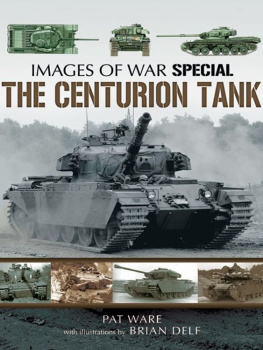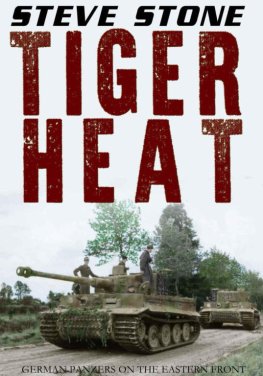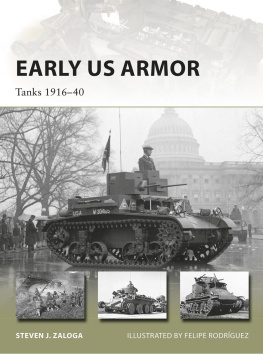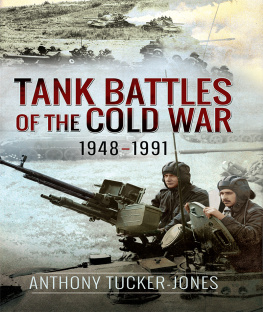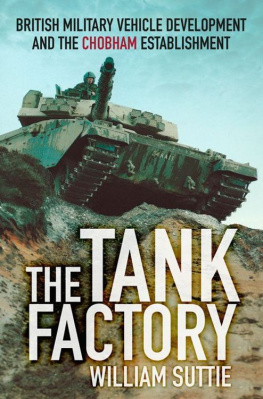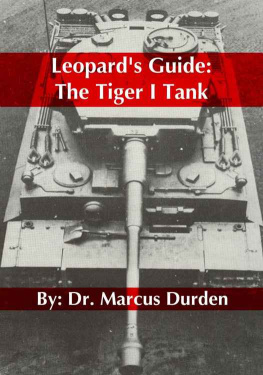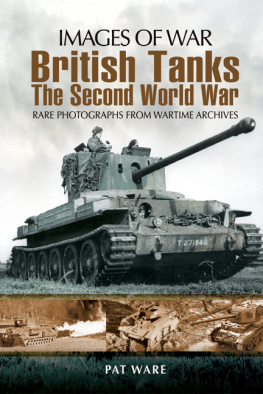
A Centurion armoured recovery vehicle (ARV, FV4006) photographed during the liberation of Kuwait in 1990/91. The registration number (00ZR48) indicates that this vehicle was converted from a Mk 1 or Mk 2 Centurion gun tank dating from the immediate post-war years. Note the additional composite armour applied to the sides of the vehicle in the form of panels. ( Tank Museum )

First published in Great Britain in 2012 by
PEN & SWORD MILITARY
an imprint of
Pen & Sword Books ltd,
47 Church Street,
Barnsley,
South yorkshire
S70 2AS
Copyright Pat ware, 2012
ISBN 978 1 78159 011 9
eISBN 978 1 78337 828 9
A CIP record for this book is available from the British library.
All rights reserved. No part of this book may be reproduced or transmitted in any form or by any means, electronic or mechanical including photocopying, recording or by any information storage and retrieval system, without permission from the Publisher in writing.
Typeset by CHIC GRAPHICS
Printed and bound by CPI Group (UK) ltd, Croydon, CR0 4YY
Pen & Sword Books Ltd incorporates the Imprints of
Pen & Sword Aviation, Pen & Sword Family History, Pen & Sword
Maritime, Pen & Sword Military, Pen & Sword discovery, wharncliffe
local History, wharncliffe True Crime, wharncliffe Transport, Pen &
Sword Select, Pen & Sword Military Classics, leo Cooper,
The Praetorian Press, Remember when, Seaforth Publishing and
Frontline Publishing.
For a complete list of Pen & Sword titles please contact
Pen & Sword Books limited
47 Church Street, Barnsley, South yorkshire, S70 2AS, england
E-mail: enquiries@pen-and-sword.co.uk
website: www.pen-and-sword.co.uk
Contents
Chapter One
Development
A lthough most people would rightly consider the A41 Centurion medium tank to be a post-war machine, the development process for the vehicle had actually started in the early autumn of 1943, more than twelve months before the D-Day landings. However the first pre-production examples did not make it into Europe until after VE day, and came too late to affect the outcome of the war. Nevertheless, it was clear from the outset that the Centurion was an excellent machine and, even with the original 17-pounder (76.2mm) gun, may well have been capable of standing up to the heavier German Tiger and Panther tanks. In fact, it would probably be fair to say that the A41 was the best tank of the Second world war that the British Army never had but it would be equally true to say that, despite being the final iteration of the flawed British cruiser tank concept, the Centurion went on to prove itself one of the best tanks of the immediate post-war period, regardless of origin. Notwithstanding its comparatively slow road speed and apparently insatiable thirst for fuel, it offered an excellent balance of firepower, protection and mobility, and was easily capable of being up-gunned.
The first Centurions entered service in December 1946, and the type saw its first combat in Korea in January 1951 with the 8th Kings Royal Irish Hussars. By the time production came to an end in 1962, almost 4,500 Centurions had been constructed, and the vehicle saw service with nineteen armies across the world, notably also fighting in Aden, India/Pakistan, the Middle East and Vietnam.
To better understand the reasons behind the development of the Centurion it is necessary to look at the generally lacklustre performance of the tanks deployed by the British Army since 1939. These can be considered to fall into three categories: the pre-war tanks which the British Expeditionary Force (BEF) took to France in 1940, most of which were abandoned there after the evacuation from Dunkirk; the newer tanks developed for the British Army during the years 1940 to 1944; and the light and medium tanks supplied to Britain by the USA under the Lend-Lease arrangements. Despite a plethora of different machines, Allied tank design had generally failed to keep pace with developments in Germany since the mid-1930s, and almost all of the tanks fielded by the western Allies during the Second world war were ill-matched to their German counterparts, in terms of both firepower and protection. The situation was not helped by the British Armys dogged insistence that tanks should be designed either as cruisers or infantry tanks cruisers were described as fast, lightly armoured vehicles that could easily penetrate enemy lines, while infantry tanks were slower and more heavily armoured to suit the role of supporting advancing infantry. Even the iconic M4 Sherman medium tank, which was deployed in all of the major theatres of the conflict, was unable to meet the German heavy tanks such as the Tiger and Panther on equal terms.
By the time the Allies landed on the D-Day beaches in June 1944, the main British tanks in service were the A22 Churchill, which was officially described as infantry tank Mk IV, the A27M Cromwell, or cruiser tank MkVIII, and the M4 Sherman, which, although not designed in Britain, was also considered to be a cruiser. None of the three was any match for the heavier German tanks and it was not until the appearance of the hybrid Anglo-American Sherman Firefly and the Cromwell-based Comet, both of which were armed with a British 17-pounder (76.2mm) gun, that the Allies were able to field a tank that was able to pose any real threat to the opposition. However neither had been designed from first principles and both could be considered to be what-if developments of earlier designs that were inevitably compromised in various ways.
With the war showing every sign of dragging on well into 1945, it had long been obvious that both Britain and the USA would require better-armed and more heavily armoured tanks to defeat the German Tiger and Panther. In the USA, work had been progressing on a replacement for the Sherman since 1942. This eventually appeared as the M26 Pershing at the beginning of 1945. In Britain, meanwhile, work on the Centurion originally simply designated A41, the name Centurion having previously been assigned to the A30 tank that actually ended up being called Challenger had started in the summer of 1943, initially with a view to seeing full-scale production under way by November 1945.
By October 1943 the British Tank Board had met to consider a paper that had been drawn up by the Army Council Secretariat describing the desirable characteristics of future cruiser tanks. Embodying all of the lessons in tank design that the British Army had learned fighting the Germans in the Western Desert, the paper was intended to provide a starting point for the development of a new heavy cruiser tank. Recognising that the existing process of allowing industry to design new tanks had not proved particularly successful, and in the light of criticisms in Parliament and in the press with regard to the weaknesses of existing tanks in terms of firepower and reliability, it was decided that the Ministry of Supplys Department of Tank Design (DTD), led by A.A.M. Durrant, would be tasked with preparing the outline design for what was being described as the A41 heavy cruiser tank. In time, the DTD would become the Fighting Vehicles Design Department (FVDD), before merging with the Fighting Vehicles Proving Establishment (FVPE) to become the Fighting Vehicle Research & Development Establishment (FVRDE).
Major emphasis was to be placed on firepower and protection, even if this was at the expense of mobility, and the new tank was intended to match the armour; firepower and automotive performance of the 75mm-equipped German Pz Kpfw V Panther in all practical respects.
Next page
